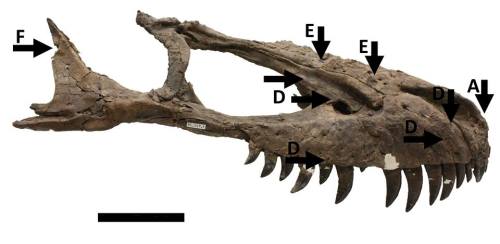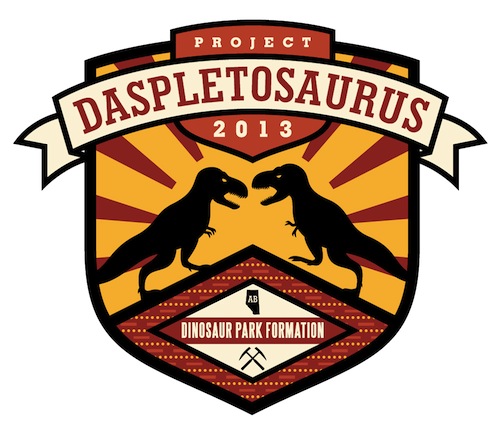 In recent years, it has become clear that at least some large theropods (and notably tyrannosaurs) engaged in some form of intraspecific conflict that can be identified by the numerous injuries inflicted on various skulls. Unlike predation attempts which would expect to strike to areas like the hindlimbs and tail, these are very localised to the face and imply animals stood head-to-head or side-by-side while doing this. Furthermore, at least a couple of records suggest cannibalism of conspecifics and this too has been seen in tyrannosaurs. Wading in myself, I have new paper out with Darren Tanke which describes a series of injuries to what is a fairly battered Daspeltosaurus skull that gives support to both of these areas, since it has both pre- and post-mortem bites on it from other tyrannosaurs.
In recent years, it has become clear that at least some large theropods (and notably tyrannosaurs) engaged in some form of intraspecific conflict that can be identified by the numerous injuries inflicted on various skulls. Unlike predation attempts which would expect to strike to areas like the hindlimbs and tail, these are very localised to the face and imply animals stood head-to-head or side-by-side while doing this. Furthermore, at least a couple of records suggest cannibalism of conspecifics and this too has been seen in tyrannosaurs. Wading in myself, I have new paper out with Darren Tanke which describes a series of injuries to what is a fairly battered Daspeltosaurus skull that gives support to both of these areas, since it has both pre- and post-mortem bites on it from other tyrannosaurs.
First off, I must thank a number of people for getting this research to happen at all. The project started while I was unemployed and obviously short of research funding. My trip to Canada to examine the material was supported by a crowd-sourced campaign run through Experiment.com. Numerous people at Experiment and huge numbers of friends and colleagues contributed (and I’m sure, plenty of regular Musings readers) and they need my thanks. First among equals was the palaeoart community with Julius Csotonyi, Luis Rey and especially Brett Booth donating artwork or sales to support the work, but many people are gratefully acknowledged. Don Henderson put me up while I was in Canada, and Darren Tanke obviously invited me to write up the specimen. While naturally a lot of work has gone into this paper, the essentials of the marks and interpretations were things Darren himself had identified years ago so much credit needs to go his way there too.
Right, onto the paper. It’s freely available through PeerJ and with 17 figures, so there should be more than enough info there for those who want to delve into the details, and thus I’ll try to keep things relatively brief here. The specimen is of something close to a sub-adult animal and there were plenty of the bones in the quarry (importantly these are in superb condition and there’s basically no evidence of transport or wear). There are numerous injuries across the skull (though absent elsewhere) and these consist primarily of healed injuries on the cranium. Not all of these can be directly attributed to bites, and some could have come from a number of sources.
However, a few healed marks can be interpreted as bites. There are some circular marks and punctures on various locations (including on the snout) and damage to bones that appear to represent some heavy impacts (deviated bones, pieces that have broken off and then fused back to the bone slightly out of position) and the like. Quite incredibly, both sides of the occipital region show some serious damage. On the left a piece appears to have been entirely removed (there’s healing round the remaining edge) and on the right, there’s a healed but circular puncture through the bone. In short, at least one and probably two separate bites came in to the back of the skull and snapped through the bones, though the animal survived and the injuries healed.
 This animal, despite not even having reached adulthood, clearly got into at least one big dustup and I would imagine, probably several, to have got so many hits to the head. Although there are a number of theropods showing injuries to the head that are interpreted as coming from other conspecifics, this is more extensive and serious than I’ve seen before. As to assigning it to a conspecific, this is tricky as there are other large tyrannosaurs in the formation (Gorgosaurus) and though these animals might well have come into conflict with one another, one can expect that conspecifics would likely come into contact more often (competition for similar niches, living in more similar habitats or direct interactions from being in groups perhaps). Thus it’s reasonable to infer this was a more likely source of such injuries.
This animal, despite not even having reached adulthood, clearly got into at least one big dustup and I would imagine, probably several, to have got so many hits to the head. Although there are a number of theropods showing injuries to the head that are interpreted as coming from other conspecifics, this is more extensive and serious than I’ve seen before. As to assigning it to a conspecific, this is tricky as there are other large tyrannosaurs in the formation (Gorgosaurus) and though these animals might well have come into conflict with one another, one can expect that conspecifics would likely come into contact more often (competition for similar niches, living in more similar habitats or direct interactions from being in groups perhaps). Thus it’s reasonable to infer this was a more likely source of such injuries.
Even so, the post-mortem damage is perhaps more interesting still. There’s one series of score marks along the inside and rear of the right dentary that well match similar bite marks from large theropods. A piece of bone has also broken off between two alveoli and been jammed down in between them and the score marks are coincident with some damage to other parts of the posterior mandible, so it looks a lot like there was a big bite here that took apart the back of the jaw. Given the position of this and the lack of healing, it’s reasonable to infer this as being post-mortem, but things get more interesting when you look at the taphonomy.
When discovered, the dentary was more anterior than would be expected if the specimen had decayed in situ (the skull was lying with the palate uppermost). However, a number of dentary teeth (including those that must have come from the missing right dentary) were lying in the palate below where they should have been if the dentaries were in a natural position. Given the lack of evidence for fluvial action generally, this implies that the jaws were originally in place, decayed sufficiently to shed their teeth, and then the dentaries were moved. One has vanished and the other is in a more anterior position than if the specimen had simply decayed in situ (and the teeth have been dragged along somehow). It’s hard to imagine the tooth ligaments coming apart within hours of death, and the lack of bites to other parts of the specimen that would have been a more obvious target for feeding suggest this was probably scavenging.
This may or may not have been cannibalistic as it is not possible to tell apart Gorgosaurus from Daspletosaurus based on the bite marks alone. Still, it is very much a record of a scavenging interaction between two large tyrannosaurs and that is a nice addition to the available information on interactions between large theropods. Getting an idea of how these kinds of things worked in past environments really is a case of building up data from the rare occasions when such interactions are preserved, so while interesting in its own right, this really does help produce a more rounded picture of interactions between large carnivores both before and after their deaths.
Finally, while I’m talking about crowdfunding stuff, do check out David Orr’s appeal for his kids book on palaeontology. David designed the snazzy logo that I used for this project as modeled by myself and Darren above, so you can see how good his stuff is. Oh yes, and here’s an interview with myself and Darren Tanke on the new paper.
































Recent Comments